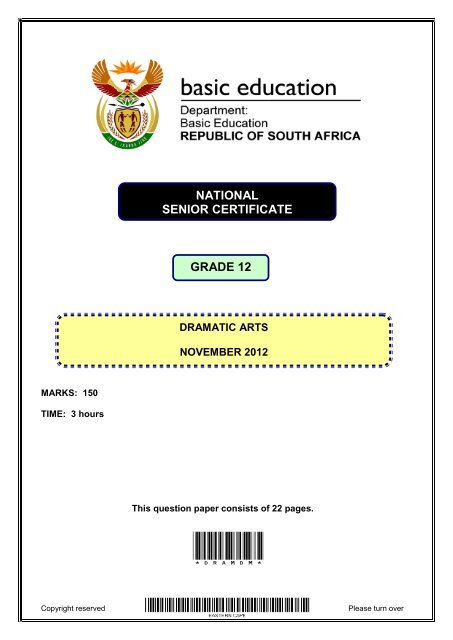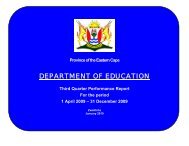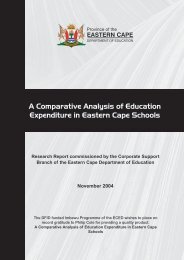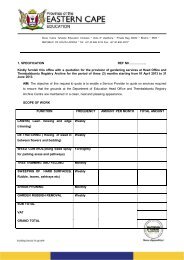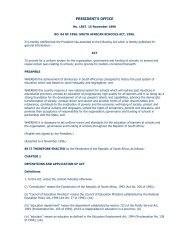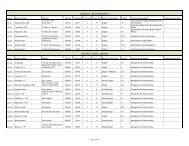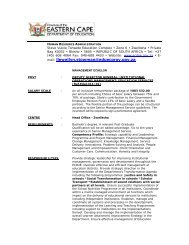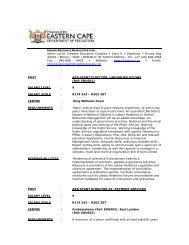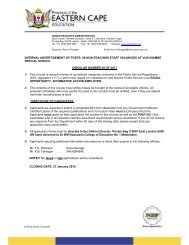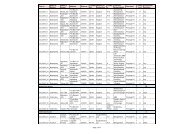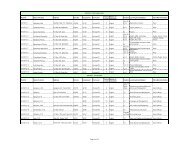Dramatic Arts Nov 2012 Eng.pdf
Dramatic Arts Nov 2012 Eng.pdf
Dramatic Arts Nov 2012 Eng.pdf
Create successful ePaper yourself
Turn your PDF publications into a flip-book with our unique Google optimized e-Paper software.
GRAAD 12<br />
NATIONAL<br />
SENIOR CERTIFICATE<br />
GRADE 12<br />
DRAMATIC ARTS<br />
NOVEMBER <strong>2012</strong><br />
MARKS: 150<br />
TIME: 3 hours<br />
This question paper consists of 22 pages.<br />
*DRAMDM*<br />
Copyright reserved<br />
Please turn over
<strong>Dramatic</strong> <strong>Arts</strong> 2 DBE/<strong>Nov</strong>ember <strong>2012</strong><br />
NSC<br />
INSTRUCTIONS AND INFORMATION<br />
1. ANSWER ONLY THE QUESTIONS ON THE DRAMATIC TEXTS YOU HAVE<br />
STUDIED.<br />
2. You have been allocated FIFTEEN minutes reading time before the start of<br />
the examination.<br />
3. This question paper consists of THREE sections.<br />
SECTION A<br />
SECTION B<br />
SECTION C<br />
(30 marks)<br />
(60 marks)<br />
(60 marks)<br />
4. SECTION A consists of TWO questions:<br />
QUESTION 1:<br />
QUESTION 2:<br />
Epic Theatre<br />
(Caucasian Chalk Circle, Mother Courage or Kanna Hy Kô<br />
Hystoe)<br />
Theatre of the Absurd<br />
(Waiting for Godot, The Bald Primadonna or Bagasie)<br />
Answer only ONE question from SECTION A.<br />
5. SECTION B consists of EIGHT questions:<br />
• QUESTION 3 (Boesman and Lena)<br />
• QUESTION 4 (uNosilimela)<br />
• QUESTION 5 (Woza Albert!)<br />
• QUESTION 6 (Sophiatown)<br />
• QUESTION 7 (Nothing but the Truth)<br />
• QUESTION 8 (Groundswell)<br />
• QUESTION 9 (Siener in die Suburbs)<br />
• QUESTION 10 (Missing)<br />
Answer only TWO questions from SECTION B.<br />
6. SECTION C consists of THREE questions.<br />
QUESTION 11 and QUESTION 12 are COMPULSORY.<br />
From QUESTION 13, answer any ONE of the three questions:<br />
QUESTION 13.1 OR QUESTION 13.2 OR QUESTION 13.3.<br />
7. Number the answers correctly according to the numbering system used in this<br />
question paper.<br />
8. Pay attention to the number of marks allocated to each question.<br />
9. Use your classroom knowledge, as well as independent and creative thinking,<br />
to answer the questions.<br />
10. Write neatly and legibly.<br />
Copyright reserved<br />
Please turn over
<strong>Dramatic</strong> <strong>Arts</strong> 3 DBE/<strong>Nov</strong>ember <strong>2012</strong><br />
NSC<br />
SECTION A: UNDERSTAND AND ANALYSE<br />
Answer EITHER QUESTION 1: EPIC THEATRE OR QUESTION 2: THEATRE OF<br />
THE ABSURD.<br />
QUESTION 1: EPIC THEATRE<br />
Answer this question if you have studied Caucasian Chalk Circle OR Mother Courage<br />
OR Kanna Hy Kô Hystoe.<br />
Brecht defined his Epic Theatre as challenging the dream world where all problems are<br />
carefully resolved; he wanted a spectator who was awake and alert. His theatre posed<br />
problems and, far from solving them, was designed to leave the audience with the task<br />
of finding solutions.<br />
Discuss in an essay how the Epic techniques and the themes used in the Epic play<br />
you have studied this year encouraged the audience to be aware and critical of<br />
society's problems. [30]<br />
OR<br />
QUESTION 2: THEATRE OF THE ABSURD<br />
Answer this question if you have studied Waiting for Godot OR The Bald Primadonna<br />
OR Bagasie.<br />
Absurd Theatre was surreal, illogical, conflictless and plotless. The dialogue often<br />
seemed to be complete gibberish. And, not surprisingly, the public's first reaction to<br />
this new theatre was incomprehension and rejection.<br />
(Jerome P Crabbe)<br />
Explain in a detailed essay how the statement above is true of the Absurdist genre.<br />
You may include the following in your answer:<br />
• Philosophy of Theatre of the Absurd<br />
• Characteristics/Features of Theatre of the Absurd<br />
• Structure of plays<br />
• Dialogue used in plays<br />
You must use specific examples from the play text to support your answer. [30]<br />
TOTAL SECTION A: 30<br />
Copyright reserved<br />
Please turn over
<strong>Dramatic</strong> <strong>Arts</strong> 4 DBE/<strong>Nov</strong>ember <strong>2012</strong><br />
NSC<br />
SECTION B: UNDERSTAND AND ANALYSE<br />
Answer only TWO questions from this section.<br />
QUESTION 3: BOESMAN AND LENA BY ATHOL FUGARD<br />
Read the extract from Boesman and Lena below and answer the questions that follow.<br />
LENA:<br />
BOESMAN:<br />
LENA:<br />
BOESMAN:<br />
LENA :<br />
BOESMAN:<br />
LENA:<br />
BOESMAN:<br />
Aikona! I'll go to the police.<br />
You tried that before and what happened? 'She's my woman, baas.<br />
Net a bietjie warm gemaak.' 'Take her' … finish en klaar. They know<br />
the way it is with our sort.<br />
Not this time! My name is Mary, remember. 'Don't know this man,<br />
baas.' So where is your proof.<br />
[Holding up a clenched fist] Here!<br />
Oppas! You'll go too far one day. Death penalty.<br />
For you? [Derisive laughter.] Not guilty and discharge.<br />
Don't talk big. You're frightened of the rope. When you stop hitting it's<br />
not because you're moeg or had enough. You're frightened! Ja.<br />
[Pause]<br />
Ja. That's when I feel it most. When you do it carefully. The last few …<br />
when you aim. I count them. One … another one … wait for the next<br />
one! He's only resting.<br />
You're right, Boesman. That's proof. When I feel it I'll know. I'm Lena.<br />
[Emphatically] And I'm Boesman.<br />
1<br />
5<br />
10<br />
15<br />
3.1 Explain why Athol Fugard chose to use a mixture of languages in the extract<br />
above. (4)<br />
3.2 Study lines 2–4.<br />
Copyright reserved<br />
3.2.1 Why did the police at that time not take Lena's complaints of abuse<br />
seriously? (4)<br />
3.2.2 How does Boesman's dialogue in these lines highlight his attitude<br />
towards abuse and domestic violence? (4)<br />
3.2.3 This play was first produced on 10 July 1969 and reflected<br />
attitudes that were prevalent at that time.<br />
Do you think that the attitude of the police towards abuse and<br />
domestic violence has changed since then? Give reasons for your<br />
answer. (4)<br />
3.3 Why does Lena not carry out her threat of leaving Boesman? (3)<br />
3.4 Describe the stage type that would suit a production of Boesman and Lena.<br />
Give a reason for your answer. (3)<br />
3.5 'Lena is Boesman's victim and Boesman is society's victim.'<br />
Discuss how the extract reveals the validity (truth) of the statement above.<br />
Refer to the extract and the text as a whole. (8)<br />
[30]<br />
Please turn over
<strong>Dramatic</strong> <strong>Arts</strong> 5 DBE/<strong>Nov</strong>ember <strong>2012</strong><br />
NSC<br />
QUESTION 4: uNOSILIMELA BY CREDO MUTWA<br />
Read the extract from uNosilimela below and then answer the questions that follow.<br />
STORYTELLER:<br />
The storyteller. The umuzi of Magadlemzini is set on the iThala. The<br />
actors populate it as the storyteller narrates. Women are busy at<br />
various household chores; men sharpen, carve, decorate weapons,<br />
drink, chat, etc.<br />
No more in the mists of legend but the living present, where in the<br />
south-west of Natal, on the banks of the Nkomazi River, there live<br />
the amaQhashi, who have been at war with the amaDedevu for<br />
over a hundred years. The amaQhashi are ruled by their king,<br />
Magadlemzini, who loves nothing more than to lie in the sun<br />
pretending to be sick. His great wife is Namdozolwana oyinyumba,<br />
barren sangoma, guardian of the cave of the Earth Mother.<br />
iThala/Inkundla. Magadlemzini's umuzi. The amaQhashi is singing a<br />
satirical song about Namdozolwana, while one of the women stands<br />
guard.<br />
1<br />
5<br />
10<br />
14<br />
4.1 uNosilimela contains elements of mythology.<br />
Identify a myth from the text and explain how it enhances (adds to) the<br />
structure and style of the play. (4)<br />
4.2 In the play uNosilimela, the storyteller assumes the position of God the<br />
Creator.<br />
4.2.1 How does the storyteller help the audience to understand the play<br />
better? (2)<br />
4.2.2 How would you dress the storyteller to represent 'the image of<br />
God'? (2)<br />
4.2.3 Imagine that you have been cast to play the role of the storyteller.<br />
Explain how you would present lines 5–11 using any TWO<br />
attributes of speech (inflection, volume, pitch, pace, pause and<br />
emphasis) to present the character of the storyteller effectively. (4)<br />
4.3 Explain how you might use any THREE props to enhance the performance of<br />
the play. Motivate your answer. (6)<br />
4.4 Carefully study the stage ground plan of uNosilimela on the next page and<br />
answer the questions that follow.<br />
Copyright reserved<br />
Please turn over
<strong>Dramatic</strong> <strong>Arts</strong> 6 DBE/<strong>Nov</strong>ember <strong>2012</strong><br />
NSC<br />
A<br />
U<br />
D<br />
I<br />
E<br />
N<br />
C<br />
E<br />
3.<br />
LIFE<br />
AREA<br />
AUDIENCE<br />
1.<br />
SPIRIT AREA<br />
5.<br />
Ishashalazi<br />
2.<br />
HIGH<br />
AREA<br />
6<br />
4.<br />
Inkundla<br />
3.<br />
LIFE<br />
AREA<br />
AUDIENCE<br />
A<br />
U<br />
D<br />
I<br />
E<br />
N<br />
C<br />
E<br />
STAGE AREAS<br />
1. Spirit Area<br />
Stage area for the supernatural<br />
Cave and/or Ithala<br />
Sacred enclosure reserved for God<br />
2. High Area<br />
Area where story is introduced<br />
3. Life Area<br />
Stage area where main events take<br />
place and audience/performers are<br />
seated<br />
4. Inkundla<br />
Stage where dramatic action is<br />
concluded<br />
5. Ishashalazi<br />
Additional stage for main performance<br />
6. Entrance and Exit<br />
Only entrance for both actors and<br />
audience<br />
[© Endlini kaGogo: IKS in Contemporary Context by Phil Manana 2010]<br />
4.4.1 Why is the audience made to sit around some of the acting areas? (4)<br />
4.4.2 State ONE advantage of this type of staging. (2)<br />
4.4.3 Discuss ONE limitation of this type of staging. (2)<br />
4.4.4 What sounds and other special effects could you use to reflect the<br />
sacred (holy) nature of the Ithala/cave? (4)<br />
[30]<br />
Copyright reserved<br />
Please turn over
<strong>Dramatic</strong> <strong>Arts</strong> 7 DBE/<strong>Nov</strong>ember <strong>2012</strong><br />
NSC<br />
QUESTION 5:<br />
WOZA ALBERT! BY PERCY MTWA, MBONGENI NGEMA AND<br />
BARNEY SIMON<br />
Read the extract from a review by Lesley Stones of the play Woza Albert! below and<br />
then answer the questions that follow.<br />
This is an extremely physical piece of theatre, with actors Mncedisi Shabangu and<br />
Hamilton Dlamini dashing around in tackies and tracksuit bottoms. They're quickly<br />
drenched in sweat, partly because the air conditioning failed and partly because the<br />
play is so demanding. It's amazing how much noise two men can make, as they imitate<br />
prison sirens, trains, barking dogs and a dozen other sounds of daily life of the streets<br />
of Joburg.<br />
1<br />
5<br />
The play by Percy Mtwa, Mbongeni Ngema and Barney Simon is stuffed with wit and<br />
satire. Shabangu and Dlamini play a variety of characters to highlight the inequalities of<br />
life when whites had it all and blacks picked up the scraps.<br />
Pink clown noses turn them into Afrikaners, emphasising the point in a subversive<br />
(rebellious) and a visual way.<br />
Both actors bristle with skill and vigour, and Shabangu's amazing facial expressions<br />
really touch the heart. Playing an old tattered tramp, he gallantly tries to thread a<br />
needle to repair his threadbare coat. The audience clapped spontaneously when the<br />
imaginary thread finally went through the imaginary needle.<br />
10<br />
15<br />
5.1 Would you be encouraged to watch a performance of the play Woza Albert!<br />
after reading this review? Motivate your answer. (4)<br />
5.2 Explain why the performance of this play is described as an 'extremely<br />
physical piece of theatre'. Give TWO reasons. (4)<br />
5.3 Explain why and how the actors use their bodies as instruments of<br />
performance to create various characters and the sounds in the play. (6)<br />
5.4 'The audience clapped spontaneously when the imaginary thread finally went<br />
through the imaginary needle' (lines 14–15).<br />
What acting technique is used here and why was it necessary to use this<br />
method? (3)<br />
5.5 Explain why Woza Albert! is a good example of a protest play. (3)<br />
5.6 Discuss TWO themes, with examples from the play, that draw attention to the<br />
'inequalities of life when whites had it all and blacks picked up the scraps'<br />
(lines 8–9). (10)<br />
[30]<br />
Copyright reserved<br />
Please turn over
<strong>Dramatic</strong> <strong>Arts</strong> 8 DBE/<strong>Nov</strong>ember <strong>2012</strong><br />
NSC<br />
QUESTION 6: SOPHIATOWN BY THE JUNCTION AVENUE THEATRE COMPANY<br />
Refer to the sources below and answer the questions that follow.<br />
SOURCE A<br />
B C<br />
A<br />
A production photo of Sophiatown showing the extract in SOURCE B<br />
SOURCE B<br />
(The household breaks into a celebratory song.)<br />
A bo tle<br />
Re ba kakqathe<br />
Ga bo pala<br />
Re bo tsho lole (x 2)<br />
(Let it come<br />
We'll drink it<br />
If it doesn't taste nice<br />
We'll throw it out) (x 2)<br />
1<br />
5<br />
RUTH:<br />
FAFHEE:<br />
RUTH:<br />
FAFHEE:<br />
JAKES:<br />
(RUTH fetches bottles of gin, brandy and whiskey, hidden in brownpaper<br />
packets. LULU hands out glasses. The song gets raucous. RUTH<br />
interrupts.)<br />
I've got a surprise! Along with the usual gift from the Yeoville shops: a<br />
bottle of special home-made Jewish Friday night wine.<br />
What?<br />
I thought we might all like to try it. It's specially made for Friday night,<br />
and today's Friday, so here we are. Who knows, the entire house may<br />
be miraculously converted.<br />
Three drops of this Jewish wine and we're all Softown Majietas.<br />
Com'on then, let's hit that bottle.<br />
(He opens the wine and pours.)<br />
Right everybody, take a glass. We'll drink a toast in Jewish wine to the<br />
Jewish girl. And here's hoping for an instant rise in circulation.<br />
10<br />
15<br />
20<br />
Copyright reserved<br />
Please turn over
<strong>Dramatic</strong> <strong>Arts</strong> 9 DBE/<strong>Nov</strong>ember <strong>2012</strong><br />
NSC<br />
6.1 Identify characters A, B and C on the production photo. (3)<br />
6.2 Why does the household break out in a celebratory song in line 1? (3)<br />
6.3 What was the purpose of including songs in the play Sophiatown? (4)<br />
6.4 Explain how Ruth, a white girl, ended up living in Mamariti's shebeen and<br />
what does this say about her character? (4)<br />
6.5 In this scene all the characters are enjoying themselves.<br />
Describe, in a paragraph, another scene from the play where the mood and<br />
atmosphere are completely different. (5)<br />
6.6 The play Sophiatown was created by the Junction Avenue Theatre Company.<br />
6.6.1 Name the process used to create this play. (1)<br />
6.6.2 Briefly describe THREE phases in the creation process. (6)<br />
6.6.3 How might this method of creating plays benefit a theatre<br />
company? (4)<br />
[30]<br />
Copyright reserved<br />
Please turn over
<strong>Dramatic</strong> <strong>Arts</strong> 10 DBE/<strong>Nov</strong>ember <strong>2012</strong><br />
NSC<br />
QUESTION 7: NOTHING BUT THE TRUTH BY JOHN KANI<br />
Study the sources below and then answer the questions that follow.<br />
SOURCE A<br />
A production photo of Nothing but the Truth showing the extract in SOURCE B<br />
SOURCE B<br />
SIPHO:<br />
MANDISA:<br />
SIPHO:<br />
MANDISA:<br />
SIPHO:<br />
THANDO:<br />
SIPHO:<br />
MANDISA:<br />
SIPHO:<br />
MANDISA:<br />
SIPHO:<br />
MANDISA:<br />
SIPHO:<br />
MANDISA:<br />
SIPHO:<br />
MANDISA:<br />
The funeral! Oh, my God! The funeral! What are we going to do?<br />
What about the night vigil? Reverend Haya is coming to conduct a<br />
small service for the arrival of Themba's body. What body? How could<br />
you do this to me? Why didn't your mother say anything to me?<br />
My mother wrote to you, Uncle Sipho, and you never replied. Anyway,<br />
I don't see the problem. That's what everybody does in <strong>Eng</strong>land.<br />
You burnt my brother.<br />
Don't say burnt. He was cremated, and that was my mother's wish.<br />
Your mother's wish. You burnt him to ashes.<br />
Daddy, please!<br />
(Pointing to the urn): What is in this thing?<br />
His ashes.<br />
All of him.<br />
Some of him.<br />
Where is the rest?<br />
You don't take all the ashes from the oven. It's symbolic. The rest is<br />
… discharged is the word they use.<br />
You mean thrown away?<br />
All right. Yes.<br />
I want them all.<br />
Oh, this is ridiculous. I didn't come here to argue about ashes.<br />
1<br />
5<br />
10<br />
15<br />
20<br />
Copyright reserved<br />
Please turn over
<strong>Dramatic</strong> <strong>Arts</strong> 11 DBE/<strong>Nov</strong>ember <strong>2012</strong><br />
NSC<br />
7.1 By describing the set and costumes in SOURCE A, explain how it enhances<br />
(adds to) the realistic genre of the play. (6)<br />
7.2 Explain why the urn on the table (SOURCE A) is a source of conflict in this<br />
scene. (4)<br />
7.3 Refer to the extract in SOURCE B.<br />
How would you direct an actor portraying Sipho vocally and physically to draw<br />
attention to his emotional state in lines 1–4? (6)<br />
7.4 Discuss the cultural differences between Mandisa and Sipho which are<br />
evident in the extract above and the play as a whole. (6)<br />
7.5 Discuss the relevance that a play like Nothing but the Truth has in society by<br />
referring to the characters, dialogue and subject matter. (8)<br />
[30]<br />
Copyright reserved<br />
Please turn over
<strong>Dramatic</strong> <strong>Arts</strong> 12 DBE/<strong>Nov</strong>ember <strong>2012</strong><br />
NSC<br />
QUESTION 8: GROUNDSWELL BY IAN BRUCE<br />
Refer to the sources below and answer the questions that follow.<br />
THAMI:<br />
JOHAN:<br />
THAMI:<br />
JOHAN:<br />
THAMI:<br />
JOHAN:<br />
THAMI:<br />
JOHAN:<br />
THAMI:<br />
JOHAN:<br />
THAMI:<br />
JOHAN:<br />
THAMI:<br />
JOHAN:<br />
THAMI:<br />
JOHAN:<br />
THAMI:<br />
JOHAN:<br />
THAMI:<br />
JOHAN:<br />
THAMI:<br />
SOURCE A<br />
There are men in the informal settlement of Rooikamp who will sell you a<br />
diamond for the price of a white pipe or a papsak.<br />
That's who you've been talking to?<br />
My parcel is growing fatter month by month. Week by week, in fact.<br />
(Shocked) You're lying.<br />
No.<br />
You're lying. Where's it?<br />
Safe.<br />
Why didn't you tell me about it before?<br />
Why should I tell you? So you can tell me it's wrong, and I must rather<br />
wait until you can get a jackpot?<br />
I thought you were my friend, my partner.<br />
I can't be that.<br />
(Johan fetches the knife, approaches Thami.)<br />
I wanted to help you, Thami. I wanted to make things right for you.<br />
I don't need you to do that for me.<br />
(Struck) No, don't say that.<br />
I don't need you for anything.<br />
(Shows the knife) I'm warning you, I'll –<br />
I know what you'll do.<br />
Don't make me.<br />
Don't make you what? Kill an unarmed man? Why not? That's what you<br />
can do.<br />
I didn't mean to –<br />
But you did! You killed a man who couldn't protect himself.<br />
SOURCE B<br />
1<br />
5<br />
10<br />
15<br />
20<br />
25<br />
A production photo of Groundswell showing the extract in SOURCE A<br />
Copyright reserved<br />
Please turn over
<strong>Dramatic</strong> <strong>Arts</strong> 13 DBE/<strong>Nov</strong>ember <strong>2012</strong><br />
NSC<br />
8.1 Which performance style would be most appropriate for this play? (1)<br />
8.2 Describe the set that one might use to support the performance style of the<br />
play. (6)<br />
8.3 What does Thami mean in line 11 when he speaks about a 'jackpot'? (3)<br />
8.4 Study line 25.<br />
8.4.1 What event is Thami referring to in this line? (2)<br />
8.4.2 Discuss how Thami's statement highlights the theme of guilt and<br />
redemption. (4)<br />
8.5 In lines 5 and 7 Johan repeats the words 'You're lying'.<br />
How would you direct the actor performing the role of Johan to deliver these<br />
lines vocally and physically to highlight the growing tension between the two<br />
characters? (4)<br />
8.6 Refer to the photo in SOURCE B.<br />
Although Johan is holding a knife, Thami's body language does not convey<br />
fear.<br />
Explain the shift in power in between Johan and Thami that culminates in the<br />
final confrontation between them. (6)<br />
8.7 Read the excerpt from a review of Groundswell below and then answer the<br />
question that follows.<br />
Post-apartheid South Africa may seem far away from here, but the tale that<br />
unravels in Groundswell (which is set there), is one many audience members<br />
may relate to quite easily. Written by Ian Bruce, this thriller follows three men<br />
who traverse a tightrope of greed and desperation in a chaotic scheme.<br />
(Diana Saenger)<br />
Do you agree that audience members would enjoy the play even if they did<br />
not know the history of apartheid? Motivate your answer. (4)<br />
[30]<br />
Copyright reserved<br />
Please turn over
<strong>Dramatic</strong> <strong>Arts</strong> 14 DBE/<strong>Nov</strong>ember <strong>2012</strong><br />
NSC<br />
QUESTION 9: SIENER IN DIE SUBURBS BY PG DU PLESSIS<br />
9.1 The characters in the play find themselves in a very specific social<br />
environment where a distinction is made between the upper and lower worlds<br />
of the suburbs.<br />
9.1.1 Name ONE character that belongs to the upper world of the<br />
suburbs and say why he/she is placed there. (3)<br />
9.1.2 In which world would you place the character of Sybil? Give a<br />
reason for your answer. (2)<br />
SOURCE A<br />
The characters strive to escape from the misery of a precarious existence.<br />
(Ernst Lindenberg from his review 'Siener is Remarkable')<br />
9.2 Discuss how the character of Tiemie reflects someone who is striving to<br />
escape from the 'misery of a precarious existence' (struggling to live). (10)<br />
SOURCE B<br />
9.3 Read the extract below from the play and answer the questions that follow.<br />
JAKES:<br />
FÉ:<br />
GIEL:<br />
JAKES :<br />
GIEL:<br />
JAKES:<br />
GIEL:<br />
JAKES:<br />
Kom, laat die oues van dae 'n slukkie drink.<br />
Sies! (Sy gaan staan by die motor.)<br />
Nee, skink maar, ou vriend.<br />
(Skink) Vir die soetgeit en die bloedgeit<br />
En die cherries se rondgeit<br />
En die halfjack se kleingeit<br />
En die moeilikgeit …<br />
(Hulle drink.)<br />
Jy moenie van moeilikheid praat nie, Jakes. Ek is in 'n lelike ding.<br />
Jy dink jý't moeilikheid! Jy moet myne hoor.<br />
Dis 'n ernstige ding wat ek in is. Ek praat nou baie waar.<br />
Orraait, let money talk. As jy groter moeilikheid het as ek, gee ek jou 'n<br />
kas van dié. Kom ons drink eers 'n lekka dikke op die ding.<br />
Ons versuip ons moeilikhede. Vrydag is Vrydag. (Hy skink weer.)<br />
Hier gaat die moeilikheid.<br />
1<br />
5<br />
10<br />
15<br />
9.3.1 In the extract above Giel and Jakes say that they have 'trouble'<br />
('moeilikheid'). Explain Giel's 'trouble'. (3)<br />
9.3.2 You are playing the character of Jakes. Explain how you would<br />
perform lines 1, 4–7 and 10 vocally and physically to make Jakes's<br />
conversation with Giel engaging (to hold the audience's attention). (6)<br />
Copyright reserved<br />
Please turn over
<strong>Dramatic</strong> <strong>Arts</strong> 15 DBE/<strong>Nov</strong>ember <strong>2012</strong><br />
NSC<br />
9.3.3 You are the director of Siener in die Suburbs.<br />
Draw the sketch below in your ANSWER BOOK and show, with<br />
reasons, where you would place/position the characters Jakes, Fé<br />
and Giel during their conversation in the extract above.<br />
Make use of the following key when indicating where you would<br />
position the characters:<br />
• J = Jakes<br />
• F = Fé<br />
• G = Giel<br />
STAGE<br />
AUDIENCE<br />
(6)<br />
[30]<br />
Copyright reserved<br />
Please turn over
<strong>Dramatic</strong> <strong>Arts</strong> 16 DBE/<strong>Nov</strong>ember <strong>2012</strong><br />
NSC<br />
QUESTION 10: MISSING BY REZA DE WET<br />
10.1 Study the sources and answer the questions that follow.<br />
SOURCE A<br />
A photo taken during the Great Depression (1929–1933)<br />
10.1.1 Describe the social and economic conditions of the Great<br />
Depression that form the background of the play Missing. (4)<br />
10.1.2 Explain how EACH of the following characters has been influenced<br />
by the Great Depression:<br />
• Miem<br />
• Gabriel<br />
• Meisie<br />
(3)<br />
(3)<br />
(3)<br />
Copyright reserved<br />
Please turn over
<strong>Dramatic</strong> <strong>Arts</strong> 17 DBE/<strong>Nov</strong>ember <strong>2012</strong><br />
NSC<br />
SOURCE B<br />
10.2 Read the extract below and answer the questions that follow.<br />
GERTIE:<br />
MIEM:<br />
GERTIE:<br />
MIEM:<br />
GERTIE:<br />
MIEM:<br />
MEISIE:<br />
MIEM:<br />
GERTIE:<br />
MIEM:<br />
MEISIE:<br />
GERTIE:<br />
Ag, Miem. Tonight's no time to be alone!<br />
(Sighs and sits down.) You can say that again. (She picks up her<br />
sacking and sews.)<br />
I was just thinking how big my garden is and how far away my<br />
neighbours are … and then, in the quiet … I heard … noises. The whole<br />
house started creaking … and the shutters banged. It was awful.<br />
Shame, Gertie. Not surprising though. (Lifts her foot and rests it on a<br />
chair)<br />
And then I heard an owl screech in the garden. You know what the old<br />
people say … well, I just threw a few things together and … I'm sorry to<br />
arrive on your doorstep like this!<br />
You did the right thing, Gertie. We all have to stand together tonight.<br />
I heard an owl last night. In the tree outside my window.<br />
My poor girl. But don't you worry.<br />
I don't want to be any trouble.<br />
No trouble at all, Gertie. You can sleep on the camp bed in my room.<br />
Meisie, take miss Gertie's things to the room.<br />
Yes, Ma. (She picks up the hat and case and exits through the passage<br />
door.)<br />
(Calling after her) Thanks, Meisie.<br />
(A soft, moaning wind can be heard.)<br />
1<br />
5<br />
10<br />
15<br />
19<br />
10.2.1 Why does Gertie say 'tonight's no time to be alone' (line 1)? (2)<br />
10.2.2 Traditionally the screech of an owl is a sign of evil.<br />
Explain how the references to owls connect to the theme of<br />
exorcism in Missing in the extract above. (4)<br />
10.2.3 Discuss how the playwright Reza de Wet uses the sound of the<br />
wind to convey atmosphere and meaning in Missing. Refer to the<br />
extract above and the play as a whole. (6)<br />
10.2.4 You are playing the role of Gertie. Explain how you would perform<br />
lines 9–11 vocally and physically to create the mood and<br />
atmosphere evident in these lines. (5)<br />
[30]<br />
TOTAL SECTION B: 60<br />
Copyright reserved<br />
Please turn over
<strong>Dramatic</strong> <strong>Arts</strong> 18 DBE/<strong>Nov</strong>ember <strong>2012</strong><br />
NSC<br />
SECTION C: APPLY PERSONAL RESOURCES AND REFLECT AND EVALUATE<br />
SECTION C is COMPULSORY.<br />
QUESTION 11<br />
Read the monologue from Mr Matwetwe by Thembile Pepetka below and answer the<br />
questions that follow.<br />
MR MATWETWE:<br />
Then … I saw a group of young boys, I suddenly returned to my<br />
earthly senses, in a panic I hid the bible under my jacket, but it<br />
was too late … One of them screamed 'Impimpi! (Spy) a walkietalkie<br />
under his jacket!' They chased me with pangas, sticks,<br />
stones. I dropped the bible while I was running … confused,<br />
crying for my life, I ran to this house (running around the stage)<br />
they closed the door, I ran to this house they closed the door, I<br />
ran to this one they closed the door, they all closed their doors<br />
because they didn't want to be contaminated (infected) by my<br />
disease. Down there at Mbizweni Square I saw a hippo (army<br />
vehicle), I thought God was with me, I ran to the hippo, but then it<br />
pulled off, the so-called protectors of my township went away.<br />
The only thing I remember after that was, I was tired, (kneels<br />
down) they put a tyre round my neck, added cold petrol over my<br />
body and set me alight.<br />
1<br />
5<br />
10<br />
15<br />
11.1 Imagine that you had to present the monologue above as part of your Theme<br />
Programme.<br />
Describe TWO exercises you would use to prepare your voice and body to<br />
deliver such a serious monologue. (4)<br />
11.2 Explain how vocal variety can be used in the monologue above to create the<br />
sense of growing fear and panic that Mr Matwetwe is feeling. (6)<br />
11.3 Ellipses (...) are found in lines 1, 3 and 5.<br />
What do you suggest should happen where these ellipses occur, and why? (2)<br />
11.4 Suggest what the other members in your group should be doing while you are<br />
delivering this monologue. (3)<br />
[15]<br />
Copyright reserved<br />
Please turn over
<strong>Dramatic</strong> <strong>Arts</strong> 19 DBE/<strong>Nov</strong>ember <strong>2012</strong><br />
NSC<br />
QUESTION 12<br />
Refer to the sources below and answer the questions that follow.<br />
SOURCE A<br />
12.1 Would you consider the performance in SOURCE A to be an example of<br />
Physical Theatre? Motivate your answer. (3)<br />
12.2 Explain whether you would prefer to watch a physical theatre performance or<br />
a performance of a traditional play. (4)<br />
12.3 How would having an all-male or an all-female cast affect the presentation<br />
of a physical theatre performance? Motivate your answer. (4)<br />
12.4 The body speaks more eloquently (powerfully) than words.<br />
Why would this statement be true for the performance in SOURCE A?<br />
Motivate your answer. (6)<br />
Copyright reserved<br />
Please turn over
<strong>Dramatic</strong> <strong>Arts</strong> 20 DBE/<strong>Nov</strong>ember <strong>2012</strong><br />
NSC<br />
SOURCE B<br />
12.5 Study the picture in SOURCE B.<br />
Do you think that the use of costumes would enhance the presentation of a<br />
movement piece? (3)<br />
12.6 Discuss TWO skills/qualities a learner would need in order to perform in the<br />
movement piece shown above. (4)<br />
12.7 Discuss THREE factors that you and your group took into consideration in the<br />
planning and preparation of your movement piece. (6)<br />
[30]<br />
Copyright reserved<br />
Please turn over
<strong>Dramatic</strong> <strong>Arts</strong> 21 DBE/<strong>Nov</strong>ember <strong>2012</strong><br />
NSC<br />
QUESTION 13<br />
Answer ONE of the following three questions, that is QUESTION 13.1 OR<br />
QUESTION 13.2 OR QUESTION 13.3.<br />
Your answer should be a minimum of ONE page in length.<br />
13.1 LIVE PERFORMANCE (CHOICE QUESTION)<br />
The audience is the most revered member of the theatre. Without an<br />
audience, there is no theatre. Everything done is ultimately for the enjoyment<br />
of the audience. They are our guests, fellow players, and the last spoke in the<br />
wheel which can then begin to roll. They make the performance meaningful.<br />
(Viola Spolin)<br />
Discuss the validity of the statements above by stating the impact the<br />
audience has on the actor and his performance.<br />
In your answer, refer to:<br />
• Performances you have watched<br />
• Your own experience of performing<br />
• Theatre practitioners you have studied [15]<br />
OR<br />
13.2 MEDIA STUDIES (CHOICE QUESTION)<br />
Reality shows like Big Brother, Survivor, Idols, America's Got Talent, et<br />
cetera, have become very popular with audiences today. These shows appeal<br />
to people because of the dream to make it big, to have their names in bright<br />
lights, to be celebrities and to be famous. In the end, the ordinary man is<br />
forgotten and only the sponsors win.<br />
Discuss the popularity of reality shows and explain why they appeal to<br />
ordinary people.<br />
In your answer, refer to:<br />
• Techniques used (for example the use of celebrities)<br />
• Audience participation<br />
• Media hype [15]<br />
OR<br />
Copyright reserved<br />
Please turn over
<strong>Dramatic</strong> <strong>Arts</strong> 22 DBE/<strong>Nov</strong>ember <strong>2012</strong><br />
NSC<br />
13.3 CULTURAL PERFORMANCE AND RITUAL (CHOICE QUESTION)<br />
'Ayibukelwa!' (SiSwati) [No spectators allowed!] 'Ayibukelwa' is an EmaSwati<br />
proverb that specifically refers to the indigenous iNcwala [self-fortification<br />
ceremony] which discourages spectatorship during the performance. In<br />
indigenous performances the audience is expected to mingle with the actors<br />
and take part in the performance. There is no distinction between the actor<br />
and the spectator.<br />
Discuss the validity of the statement above.<br />
In your answer, refer to:<br />
• The ceremony above<br />
• Any other cultural ceremony that you practise or are familiar with<br />
• The relationship between the actor and the audience [15]<br />
TOTAL SECTION C: 60<br />
GRAND TOTAL: 150<br />
Copyright reserved


